1
HOME > Interviews >
IN CONVERSATION WITH PATRICK GRANT AND MAT HEINL
Written by Bec Loades in Interviews on the 27th July 2019
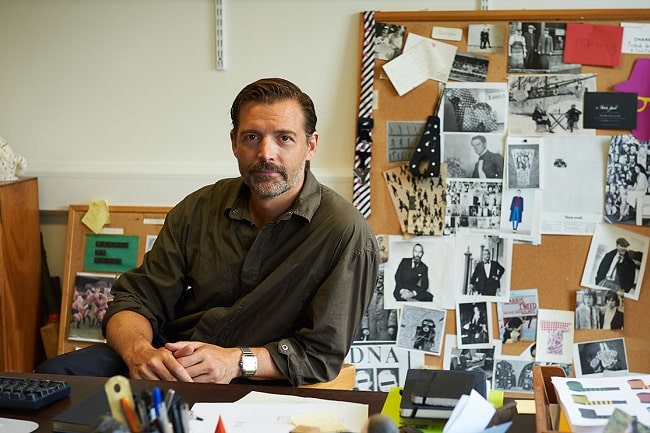
Reinventing a brand can be a serious challenge with potentially critical results; whether that be developing and altering assets that have been created over the last 5 or 150 years. Two people who understand how important it is to embrace the heritage of a brand and not dismiss the history, is Mat Heinl (CEO of global creative company, Moving Brands) and fashion designer and director, Patrick Grant. Using their multifaceted, extensive, design experience, they have recently produced a wonderfully artistic campaign for Savile Row bespoke tailors, Norton & Sons, along with the helpful hand of artist, and co-founder of Moving Brands, Ben Wolstenholme.
MenswearStyle had the fortunate opportunity to draw Mat and Patrick away from their hectic schedules for a chat about their recent campaign, amongst other fascinating topics, at Moving Brands’ impressive Shoreditch office. With a brief tour prior to our sit-down, it was instantly clear how widespread Moving Brands work has spanned. Mat explained how one of the company's first major clients, back in 1998, was Nokia with just 5 people in the office. They have now grown to four international offices, having worked with behemoth businesses such as Virgin and Apple, as well as a variety of smaller startup brands, and of course, Patrick's many ventures. Speaking to both of them, and learning how they work together, it is understandable how their relationship has been a success from the beginning. As Mat pointed out, it was all about timing as they were introduced at a time when Patrick was taking over at Norton & Sons, which he acquired back in 2005.
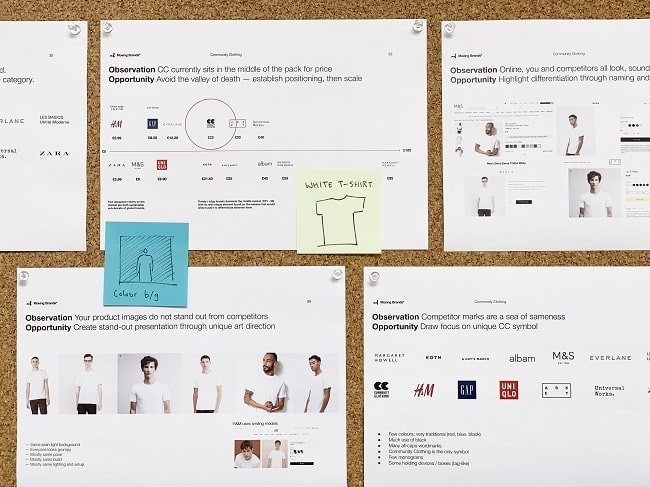
Their most recent collaboration has come together in the form of a series of illustrations, physically drawn by Ben, who has his own passion for storytelling. Each image portrays a gentleman in an individual scenario, wearing a Norton & Sons suit. What might appear at first as just a beautiful and talented piece of art, actually has many layers that delve into the heritage of the brand, bringing it into the modern world. This is no easy task, but one which I believe they have certainly achieved. The illustrations are part of Patrick’s clever method of developing Norton & Sons’ image and reminding customers just how important it is to consider quality over quantity when it comes to buying clothes. Something which is also reflected in his other brands, including Community Clothing, which was set up in 2016. It was fascinating talking to this creative team, which certainly widened my eyes to the world of ‘branding’ and the challenges a historic tailor can face, particularly in the current situation of fast fashion. Norton & Son’s story dates back to 1821 and Patrick, along with the guidance and skills of Moving Brands, has managed to embrace its legacy, as well as its craft, whilst moving it forward with the times.
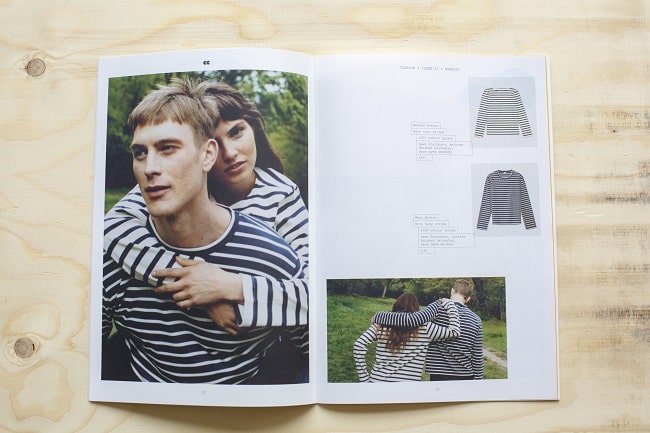
Could you explain a bit about your business relationship together and how Moving Brands has assisted Norton & Sons with it’s transformation?
Patrick: “When I took over at Norton & Sons, I felt like there weren’t that many things we needed to do but one thing that was important was to tidy up the brand identity; be clear about its story, what it was offering to the world, and obviously, how we presented ourselves both physically and digitally. The guys at Moving Brands completely understood what we were about and where I wanted to position Norton & Sons. It was a tricky balance to strike because we were working with a business with a long history and we didn’t want to alienate any of our existing customers. We wanted to polish what we had, a certain amount, and it felt on the right side of the modernity line. So, for anyone who was looking at it as new, would see this as a business that was looking forward and not backwards.”
Mat: “Early on, in one of the first meetings, we asked Patrick; ‘what are you trying to achieve, what’s the problem?’. Patrick said; ‘all my customers are dying!’ Which is kind of an off-the-cuff statement, but it’s actually quite precise. Often people move away from the past, maybe something bad has happened, or a new opportunity has come about. In this case we all realised, particularly Patrick, there is so much value in the past, but not being old fashioned. Striking that balance is where we spent a lot of time thinking about it carefully.”
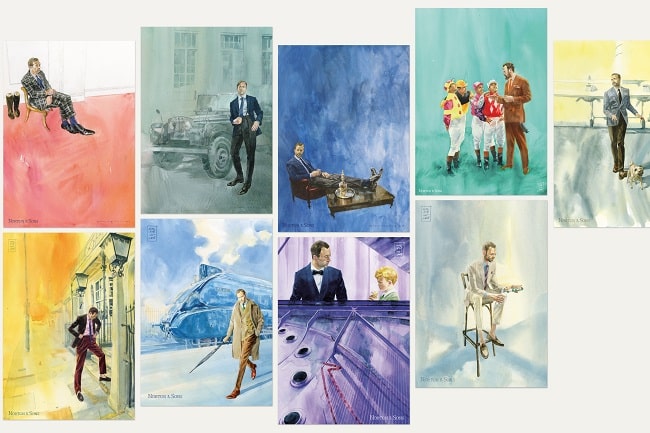
So was that the key thing with Norton; to maintain its heritage and tradition but attract more modern and younger clients?
Patrick: “Not necessarily a younger client. You don’t start shopping on Savile Row in your early twenties, unless you are doing exceptionally well, but what we wanted to do was make sure for those who were looking, they could find a contemporary, bespoke, tailor. What we offer is actually very modern; we are offering clothing that is made specifically for you, with a service that is incredibly personal and clothing that lasts. Savile Row has a reputation as being a bit ‘fuddy duddy’. I wanted to celebrate all of that - we are small, local and making things by hand in a world of mass manufacturing. It’s about reminding people how lovely it is to go back to something simpler, more timeless, and where everyone in the business is an expert and cares greatly about what they produce.”
Mat, did you see your initial work with Norton as a complete rebranding?
Mat: “No, I think we saw this as a little bit of archeology and really finding the value - it was definitely there but confused and hidden. One of the most joyful parts for me was when we went through the process of having the suit fitted - we saw how it all worked. We spent time in the workshop and sat with Patrick investigating the history of Norton & Sons; where it had come from, who had owned it, and the different guises it had over the decades. Some things we lifted straight out of the archives but there were some aspects we had to let go because they just didn’t work. I personally prefer that kind of work where it’s not trying to hark back to the past but it’s saying it has roots. There is a story and let’s tell that story because it’s still amazing.”
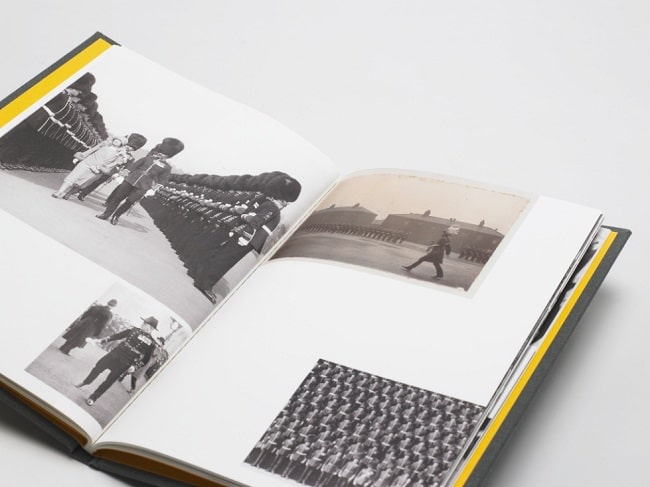
What was the aim with the illustrations and how did they come about?
Mat: “Patrick and I catch up regularly and he had spoken about the fact that he wanted to do illustrations. I instantly thought Ben could do it; he is an incredible illustrator. What you see in Ben’s work is an innate understanding of the brand and it’s a very natural way to express it. We didn’t need to have much debate about this feeling like the right direction. As usual, Patrick had some awesome references; various different stories from customers that influenced the direction of the work. Each one of the scenarios has a meaning to it.”
Patrick: “One of the things we know about our customers is that making the leap from a square of fabric in a book to a finished garment, can be difficult to visualise; how it falls and how it fits. Choosing a grey suit is easy, but what does this particular window pane check with different colours look like, with this shirt and trousers. It was always important we showed this with illustration and not photography because you can control how an illustration looks. We also wanted the customer to imagine themselves in the clothes, and I think that is much easier with an illustration. Illustration is having an interesting moment right now, particularly in the fashion world - it dropped off for a time. I think the images are contemporary and the clothes look great. Ben went to great pains to make sure the images are absolutely accurate, in terms of proportions and colour. The way we do it, we physically make the samples and then we photograph them, on either myself or someone in the shop. Ben then illustrates them from a photograph. We pose exactly the way we want to pose so we can see the way the check and crease fall. In menswear, everything is about the detail. Ben has managed to strike an amazing balance between creating beautiful looking images and also being incredibly accurate.”
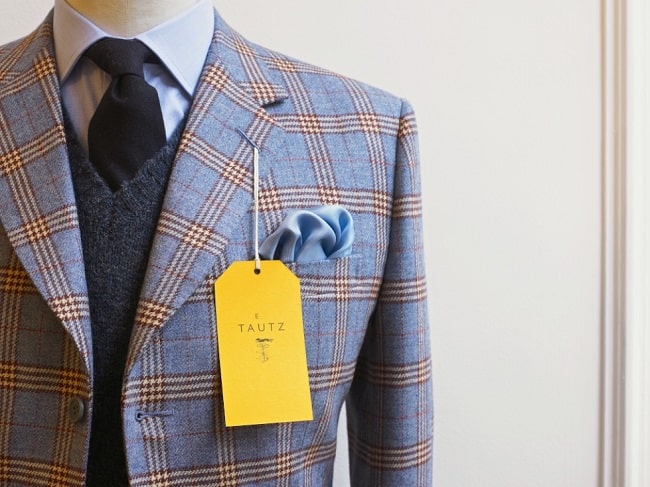
Patrick, do you feel there has been a good response from your customers?
Patrick: “Customers have really warmed to it. We actually print these as postcards to send to them. We want a little moment of joy to come through the post. Some customers come in with the postcard and say 'I like this jacket and trousers, can you show me the cloth?', so we know its had a positive impact. The quality of the final product has been beyond what I expected originally - they are lovely objects. We will continue to have them printed - in full-size too - to have in the fitting room and in the more private area of the shop.”
How are you finding things on Savile Row, with reference to the position of sustainability?
Patrick: “I think what we are doing is incredibly appropriate for where we are now in the world of fashion. We have to make changes to how we view our clothes. The process of having something made bespoke invests so much of ‘you’ in the garment - it takes on a value that no other garment will hold. We have a big problem in undervaluing our clothes and partly that is to do with price, but also to do with the process in which you buy them. We buy clothing sitting on a bus on our phone, it costs a fiver, you don’t really care if you wear it or not - it’s valueless and dangerous. What we are doing is making sure people value their clothing, not because of the price and made with wonderful material, but because they have invested part of themselves and time. People bring them back; we re-line them, alter them and fix them so they can be continued to be worn for considerable periods of time. Having something bespoke, where you are involved in the process in a meaningful way makes that object more special. You will love and cherish it and that is so important in today’s disposable clothing culture.”
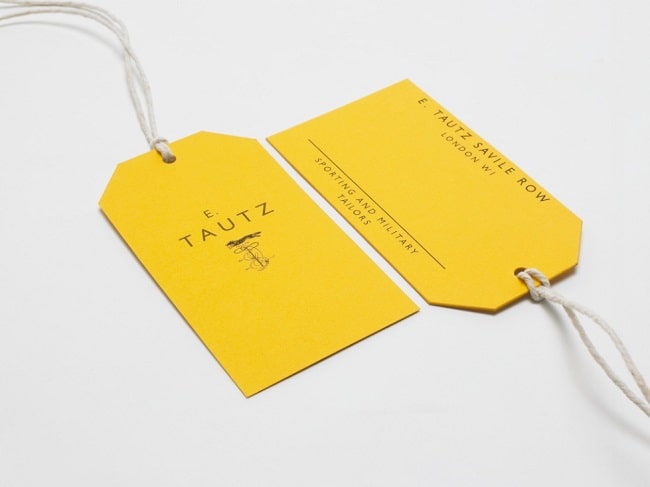
Do you think the situation will change gradually?
Patrick: “Yes because it can’t continue the way it is. It’s not going to change quickly and it’s not going to change without the incumbent fast fashion businesses really fighting hard to stop it changing, despite them telling us all about ethics and this green-washing going on. It will have to change as the oil will run out. Even if we start recycling, it is very expensive and it’s still much cheaper to make clothes out of virgin synthetics than recycling it. There is already a big backlash and there is a strong pro-vintage movement happening amongst young people.”
As a brand, is sustainability something you feel you need to point out to your customers?
Patrick: “It is something I try and point out across all of my brands. People need to buy less and buy better. There is also the problem with toxicity. The reason this stuff is so bad and so toxic is people want it for so little money. If you paid a fair price for things that you bought, then you wouldn’t have to use dark, polluting, awful, dyes and deeply environmentally-destroying processes. All of this does come at a price and I realise not everyone can afford Savile Row prices, but people just don’t need to buy as much clothing as they do. What they do buy should be ensured that it is as well-made as possible so they can keep it for a long time.”
Mat: “People tend not to understand the net asset value of the things they buy. It’s not just clothing, it’s everything. They also don’t understand the impact it has when they are buying it and how it causes damage further down the line. It’s important for people to not see ‘age’ negatively. Age makes it better; it makes it more worn, more beautiful and it has stories attached to it. It’s important to reinforce the message that things that last, are good! People should want high quality products and they tend to come from companies and organisations that: treat people better, have a purpose, provide better working conditions and think about who their suppliers are. Companies like Norton & Sons and Company Clothing build their business model on this way of thinking.”
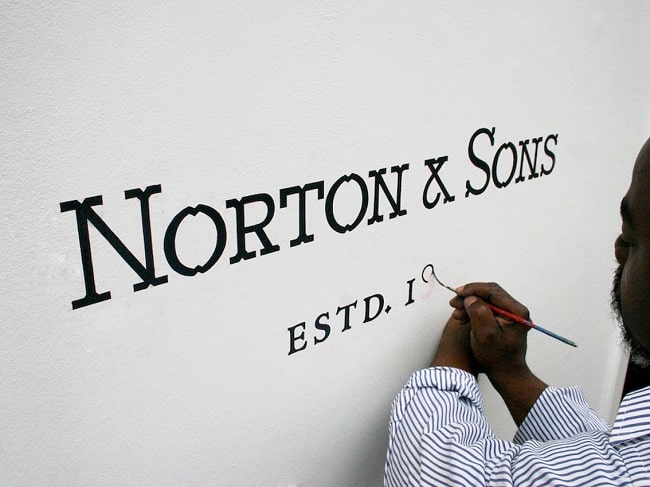
Is it easier to take a brand that is new, which hasn’t found its identity, and mould it from scratch, or an older company and ‘re-mould’ it for the modern world?
Patrick: “I’ve done both. Norton and E Tautz are very old, and Community Clothing is brand new. I think any brand worth its salt has a very clear purpose and message to tell, and the identity should help to tell that. I personally don’t think it’s any more or less difficult depending on whether you have existing assets or not. Everybody within the business needs to understand what they are there for and if they do something that serves a need of a customer, then they will succeed. I believe all our companies live and breathe everything they do. Community Clothing was certainly built on this principal. It’s like a stick of rock with the same message that follows all the way through.”
Mat: “I agree with that. The key thing is to know why you’re doing something in the first place. Also, the emotional value of it. If you are inventing something from scratch you can look at it as: ‘no one knows me, I have to start everything from the beginning’. So, it’s really about taking a step back to know why you are doing it, know where your heart is in it, and make sure you apply the effort to the thing that matters in that particular context. I’ve seen brands with a strong history try to reinvent the heritage. The heritage is the heritage, there is no need to touch it. The ‘newness’ can be applied elsewhere. What’s most important, whether it’s a new or ‘old’ company is that they know why they are here and why it is valuable to customers/clients.”
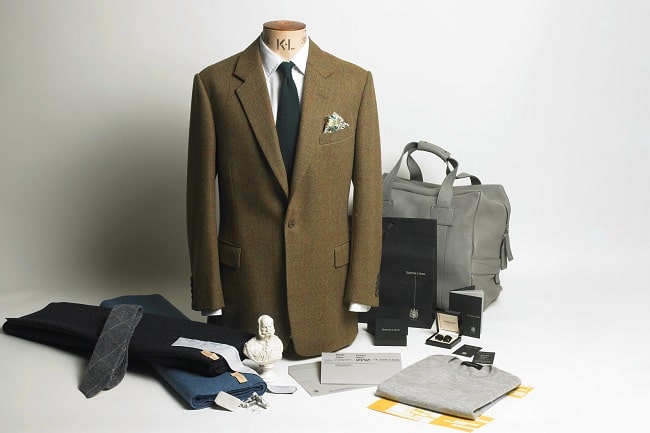
Going forward, is there an aim/goal for the relationship between Moving Brands and Norton?
Patrick: “With Norton, we are very happy with the way that our business is running at the moment. We always think about how to fine tune and maintain it, and our position of relevance in the way men dress. Mat and I meet up regularly for conversations with no specific fixed agenda. We find Moving Brands are a brilliant resource for talking things through - they understand the way people think and they have an interesting and important take on the world. We tend to bash around ideas with their team, which not only helps crystallise our ideas but helps all of our team understand everyone’s position and perspective. We hope to continue that.”
Mat: “I’ll hold you to that, Patrick! Our mission is to be an amazing partner to all of Patrick’s ventures. Community Clothing is one of the newer ones, but we feel a very strong affinity to their philosophy and so we will do everything to help with it.”
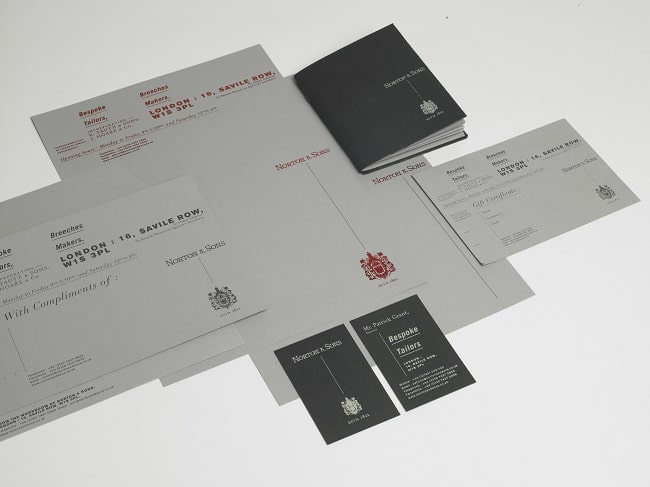

Trending
2
3
4
5
6
7
8
9
10












